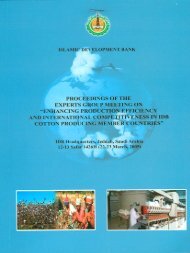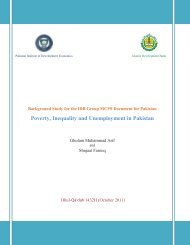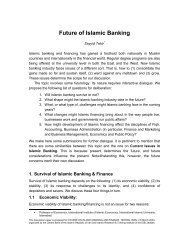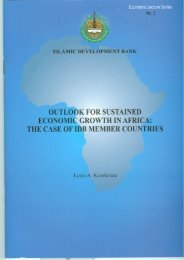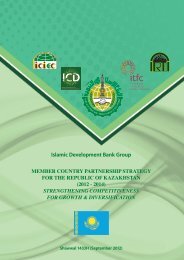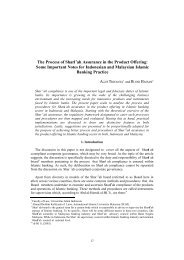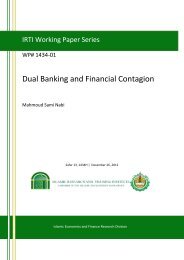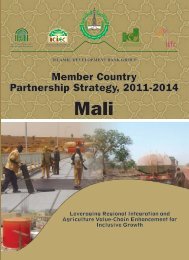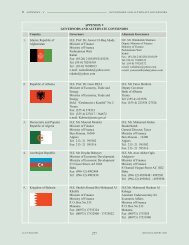Country Economic Work for Malaysia - Islamic Development Bank
Country Economic Work for Malaysia - Islamic Development Bank
Country Economic Work for Malaysia - Islamic Development Bank
You also want an ePaper? Increase the reach of your titles
YUMPU automatically turns print PDFs into web optimized ePapers that Google loves.
the incidence of rural poverty<br />
(8.4%) was significantly higher<br />
compared to urban poverty of 1.7%<br />
in 2009 (Figure 1.6). During the<br />
Tenth <strong>Malaysia</strong> Plan period, the<br />
Government plans to reduce<br />
poverty further to 2% by 2015.<br />
Per Capita Income (US$)<br />
70<br />
60<br />
50<br />
40<br />
30<br />
20<br />
Figure 1.7. <strong>Malaysia</strong>: Real GDP Growth and<br />
Per Capita Income, 2000-2015<br />
14,000<br />
10<br />
12,000<br />
10,000<br />
8,000<br />
6,000<br />
4,000<br />
2,000<br />
0<br />
Figure 1.6. <strong>Malaysia</strong>: Incidence of Poverty<br />
(% of households)<br />
12. In order to achieve highincome<br />
10<br />
advanced country status<br />
by 2020, <strong>Malaysia</strong>n economy<br />
0<br />
needs to grow by an average<br />
annual growth rate of around 6%<br />
Overall Poverty Urban Poverty Rural Poverty<br />
during the 10 th Plan Period<br />
(2011-2015), taking into account<br />
Source: <strong>Economic</strong> Planning Unit, Government of <strong>Malaysia</strong> (www.epu.gov.my)<br />
the risks associated, notably from<br />
the return of high food and fuel prices, sluggish recovery in developed nations, debt crisis in some<br />
European countries and USA, and instability due to volatile capital inflows. Further, the main<br />
risks to medium-term growth have been identified as re<strong>for</strong>m implementation risks, slow progress<br />
on fiscal consolidation, and the quality of public service delivery. <strong>Economic</strong> growth also needs to<br />
be based on more innovations with<br />
greater emphasis on the quality of<br />
capital and high labor efficiency in<br />
its production system through<br />
addressing the long-standing<br />
problem of brain drain and the lack<br />
of skilled labor. This translates into<br />
the course of achieving high<br />
income status that the country will<br />
have to raise current GNI per capita<br />
from $9,575 in 2011 to a highincome<br />
target of $12,139 by 2015<br />
and to over $15,000 by 2020<br />
through inclusive and sustainable<br />
growth (Figure 1.7).<br />
Per Capita Income (US$) Real GDP Growth (%)<br />
Source: <strong>Economic</strong> Planning Unit, The <strong>Malaysia</strong>n Economy in Figures<br />
13. Despite remarkable achievements during the last decade, <strong>Malaysia</strong> appears to be<br />
facing the so-called “Middle Income Trap”. In the post-war era, like many countries, <strong>Malaysia</strong><br />
developed rapidly and moved into middle-income status. Out of 101 middle-income economies in<br />
1960, only 13 countries escaped this middle-income trap and became high income by 2008. 3 The<br />
factors that propelled high growth in <strong>Malaysia</strong> during its rapid growth phase were low-cost labor,<br />
8<br />
6<br />
4<br />
2<br />
0<br />
-2<br />
-4<br />
Real GDP Growth (% p.a.)<br />
3 These countries include Equatorial Guinea, Greece, Hong Kong, China, Ireland, Israel, Japan, Mauritius, Portugal,<br />
Puerto Rico, Republic of Korea, Singapore, Spain and Taiwan.<br />
9







